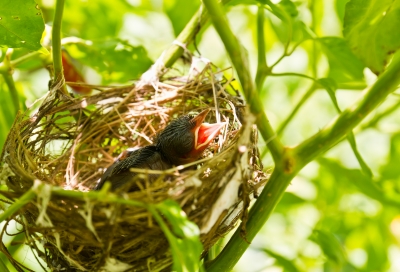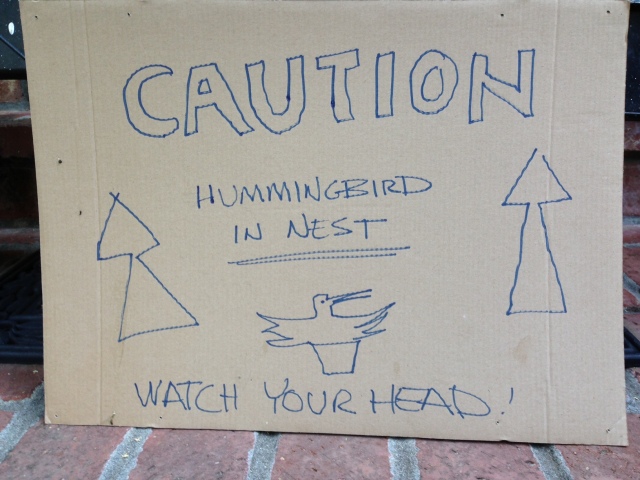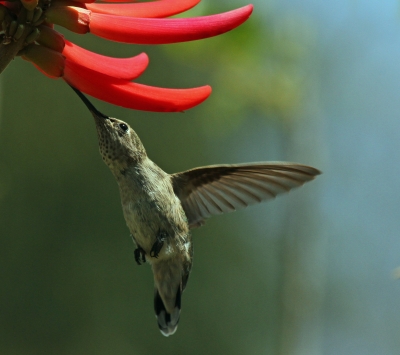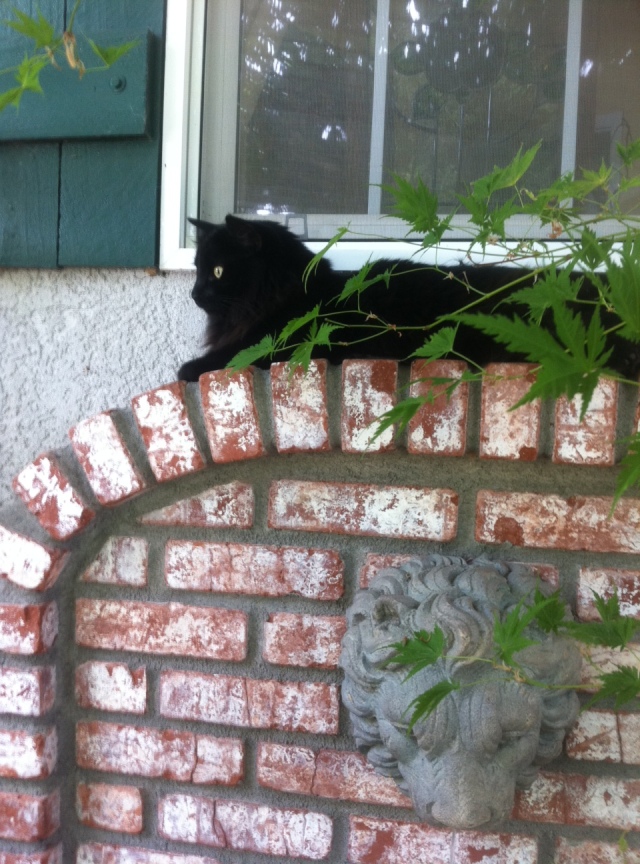Summer is coasting to an end and the fledglings are leaving their nests. Go figure. I always thought this happened only in spring. Shows how little I know about avian procreation. And yesterday we witnessed a scene which has been going on relatively unnoticed for let’s say, oh, millions of years, ever since the first fledgling dinosaur trotted off on its own. And let me tell you, it was awe-inspiring.
Okay, here’s the scene: Several weeks ago a mother robin adopted an abandoned robin’s nest under the eave of our garage. Now in all honesty, I didn’t think much of her brain power, because California summers are hot and getting hotter, and this location is bathed in radiant heat from the concrete surface below and reflected light from the white garage door. The extended eave acts as a heat catcher, so I imagine that nest was warm enough to incubate eggs on its own without the aid of a warm mother bird’s body.
Oh, wait, maybe that’s not so bird-brained a location, after all? And the recycling of an old nest…pure genius in terms of energy efficiency.
Anyway, there she is, up there daily, ignoring the raucous racket every time my car pulls in and out, every time the noisy garage doors rise and fall, and she faithfully attends those eggs. But when the temperature exceeded 100 degrees, she knew enough to stand on the side of the nest rather than heat up those eggs to hard-boiled status.
The poor thing was obviously distressed by the heat, her beak open constantly in panting mode. So I set up a fan beside the car and directed the wind in her direction, and within a minute she shut her beak. I’m sure she would have given me the thumbs up, or flight feathers up, or whatever a mother bird would do to express her appreciation. But in actuality she just turned into the breeze and relaxed a little, which was all the thanks I needed.
So soon there are several ugly little hatchlings, their open beaks raised high in the air, their scrawny necks stretched long, their voices quiet when mom is gone chasing down some juicy insect, noisy when she arrives to share all that regurgitated goodness.
Now about this time a second nest appears, this one the size of a big thimble and this time attached to a Japanese maple branch inches above head height at our front porch entry, which thankfully we seldom use. And there sitting atop the nest is a tiny hummingbird (not that I know of any giant hummingbirds), so forget the “tiny,” just think hummingbird. She sits on her nest and spreads her wings. And we decide never to use the front door, and place a barrier on the steps and a hand-drawn sign cautioning anyone approaching.
Time to flash forward to the day before yesterday. First of all, my wife and I are convinced the hummingbird nest has been abandoned, since every time we peek through the side light of the front door, the mother is nowhere to be seen. Morning, day, evening, night…no mother tending the nest. In concern, I finally sneak out and stand on a chair to peer into the nest, and there are three little lumps of fuzz about the size of almonds. And I can see the minuscule bodies rapidly breathing in and out, but their heads are buried in the nest. Arrrghh, I say, or something to that effect. The poor things are alive, but not for long.
What to do? We research and learn that the mother bird should be tending to their food needs four to five times an hour. But what if she is around, doing her motherly duties, and we just never catch sight of her. We read that she only in at the nest for a few seconds each time. Double arrrghh…okay, we’ll wait another day. My wife and I take turns peeking out for motherly activity, not telling each other because we know we’re both upset by the thought of birdlets starving to death and don’t want the other to be depressed. Finally, the decision is reached. Give Mother Nature a chance. After all, these living dinosaurs, petite as they may be, didn’t survive into the present day without some sense of what they have to do to protect their young.
So yesterday morning we are awakened to an incredibly noisy squawking of birds in our front driveway. When I look out on a typical morning I see the landscape dotted with many of the semi-feral cats we look after, ever since the people up the way abandoned them to their fates when they moved away. At six to seven in the morning they always appear like magic, awaiting the grand opening of the garage doors and plates of fresh food and bowls of water. But yesterday morning all was different. No cats at all. Or rather, wait…two are all the way up by the front gate, looking my direction but patiently waiting and eyeing a flock of robins.
Yes, a flock. Five adult robins, screeching and squawking at the cats to keep them at bay. And in the middle of the driveway squats one little fledgling robin, the last to have left the nest.
Now I—less than confident that one of the cats isn’t lurking and ready to grab that bite of fluff—creep out the door and approach the fledgling, reach down and scoop it up gently, carry the little creature to the garage eave and try to put it back up on the branch supporting its now empty nest. All the while robins are noisily swooping down at my head, the fledgling deposits some nice liquid goop in my hand, and then flutters clumsily down into the bushes at my feet. Mission a disaster.
All this activity has drawn the curious cats. They figure, hey if those big guys are there then the birds won’t notice us. So my wife and I now grab cans of cat food and lure all the felines as far afield as possible, and lock the most interested one, yeah, the one already sniffing at the bushes, inside the garage. Then we set up observation posts well away from the defensive robin action to wait it out, my wife up above the drive, I down below.
For two hours the adults try to encourage the fledgling out of hiding, and she eventually emerges to make her way unsteadily on foot back out across the driveway and then into bushes close to the house. All the while a couple of the adult robins return constantly with food for that young one (and presumably they are also away feeding the fledglings that were strong or bright enough to fly the first time), while others stay on post to watch for danger, and others demonstrate what the fledgling needs to learn. These trainer birds land in the bush with the slow-learner, hop up a branch, then onto the next higher branch, etc., obviously hoping to get the little bird to copy their actions until it is high enough to get some air and fly away to join its somewhat more advanced siblings.
But here’s what I found most fascinating about this nature lesson: Not only were several adult robins in on the training, but at least four hummingbirds joined in the moment, flitting in and out of the bush and apparently also encouraging the fledgling (four times their size) to climb up the branches. They obviously were there only because they recognized that their fellow birds had a baby to save. You got it, distinctly different bird types coordinating the rescue of a young one!
I imagine that untold generations worth of bird sense led to their knowing what to do, and they all did it. Eventually, the birdlet got the message and joined all the others in the oak trees.
Accepting that the “abandoned” hummingbird babies in the nest over the porch might well be long dead from starvation by now, and no longer wishing to worry about them, I checked out that nest. And there were three tiny birds, now about the size of large macadamia nuts, pointy little beaks held high, alive and awaiting mother’s return. I went to tell my wife that they lived, and she shared with me that, from the top of the drive watching the birds rescue the fledgling, she had seen a hummingbird darting in and out of the Japanese maple over the front porch, four or five times during an hour, staying mere seconds each time.
I think I’ll eliminate the term “bird-brained” from my vocabulary. It just doesn’t seem appropriate anymore.






Great story, Patrick! Lots of visuals. Your blogs are always so enjoyable to read!
Glad to hear you are enjoying them, Cynthia. Seems nature always has a new surprise for me! Thank you for your comments!
Hi Patrick,
Your blogs are always fun and interesting to read. This one was a change from your world travels but nature stories are equal to travel stories!
Mary Ann
Hi Mary Ann,
Thanks for your nice comment. I’m glad you are enjoying the blog posts.
We have a robin nest on our patio cover right now. I hate it when they leave the nest ill prepared for life’s troibles……
Gotta agree, Fred. Troibles and foibles…